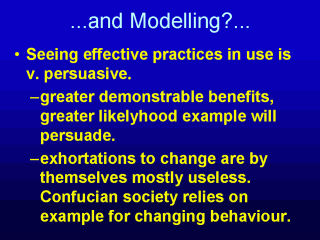| front |1 |2 |3 |4 |5 |6 |7 |8 |9 |10 |11 |12 |13 |14 |15 |16 |17 |18 |19 |20 |21 |22 |23 |24 |25 |26 |27 |28 |29 |review |
 |
Observing effective practices is
a good way to prompt increases in effort to change. Through a series of simple steps which
ensures success, people can learn to increase their perceptions of self-efficacy. Together
with increasing perceived self-efficacy, modelling and guided practice are good ways to
teach behaviour change skills. All that remains then is the need to demonstrate benefits
from maintaining the new behaviour which outweigh the influences or benefits of returning
to the previous behaviour. The greater are the demonstrable benefits of behaviour change, the greater will be the likelihood that change will be tried. Simply asking or telling people to change will not be very helpful, and are usually pretty useless. In traditional Confucian society, behaviour is taught by example by older and more experienced members of the community and emulated by younger members. Various incentives and disincentives traditionally helped people to adhere to strict protocols of behaviour. |